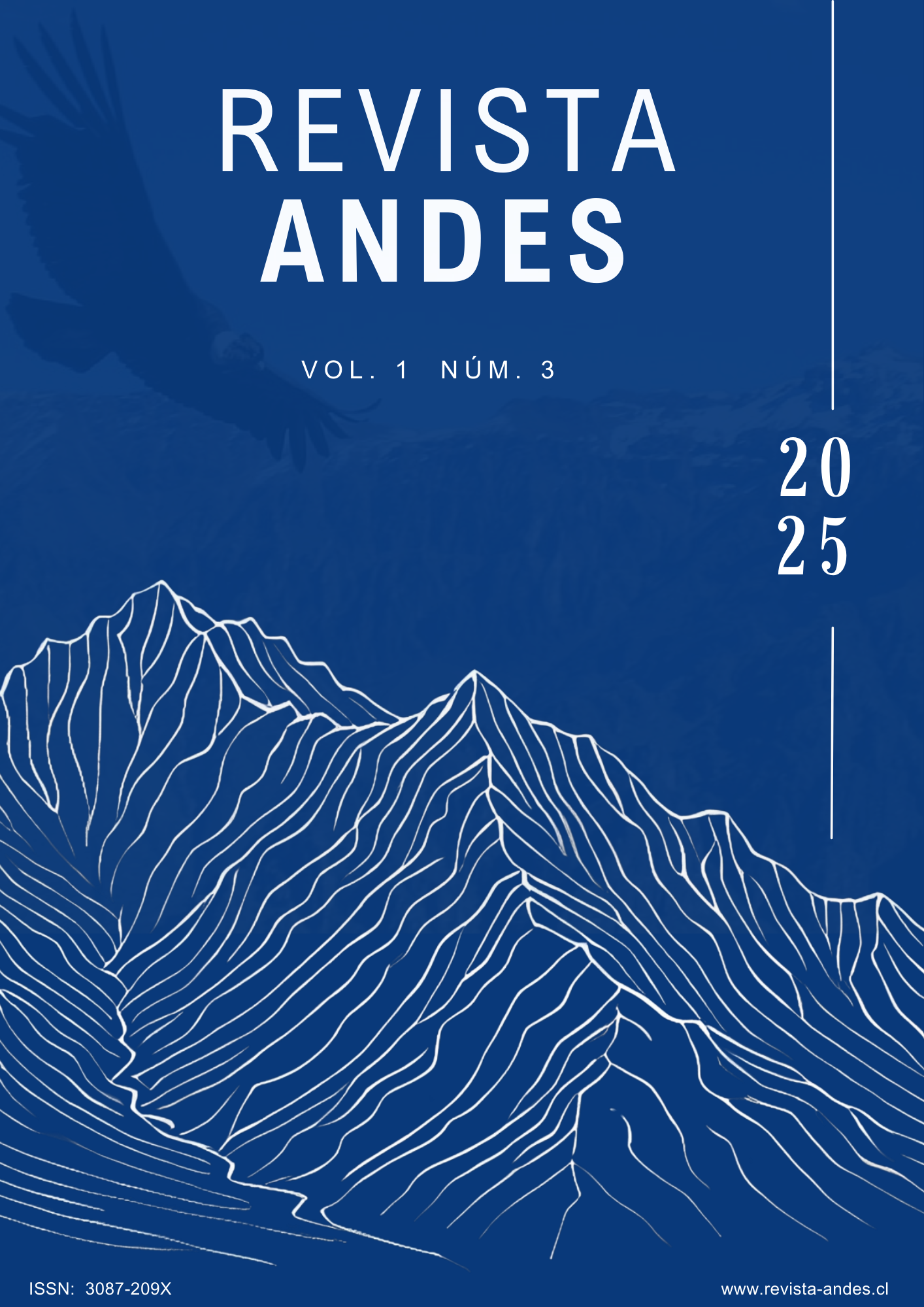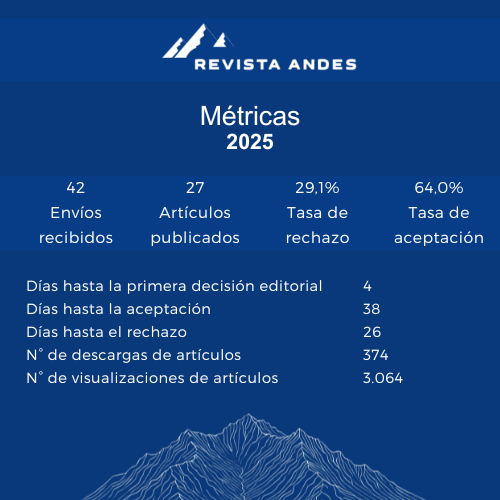Hospital Discharge Rate for Bipolar Affective Disorder in Chile (2020–2023)
DOI:
https://doi.org/10.5281/zenodo.17185338Keywords:
Chile, Hospitalization, Psychiatry, Bipolar Mood Disorder, EpidemiologyAbstract
Introduction: Bipolar Affective Disorder (BAD) is a chronic mental illness characterized by significant mood disturbances ranging from episodes of mania to depression. Objective: To determine the hospital discharge rate for bipolar affective disorder with manic episodes, with and without psychotic symptoms, between 2020 and 2023 in Chile. Methodology: Observational, descriptive study. Data were obtained from the Department of Health Statistics and Information and the National Institute of Statistics. Results: The highest hospital discharge rate (HDR) was recorded in 2023, with a value of 3.88 per 100,000 inhabitants. Women reported the highest number of cases, with 4.28 per 100,000 inhabitants. The 20–44 age group had the highest HDR, with 5.72 per 100,000 inhabitants. BAD with psychotic symptoms was the most frequent condition (62.2%). Discussion: The increase in HDR after the pandemic may be associated with the reconversion of hospital beds, resulting in greater availability for mental health care. Females had the highest HDR, consistent with the literature, possibly due to biopsychosocial factors leading to more severe clinical presentations. The 20–44 age group across both sexes concentrated the majority of cases, which may be due to social factors causing greater psychological burden. Conclusion: Mental disorders are increasingly prevalent in society, and various stressors present in modern life may act as triggers, as is the case in BAD. We recommend conducting studies with a greater number of variables to enable more efficient public health decision-making.
Downloads
References
[1] American Psuchiatric Association. Diagnostic and Statistical Manual of Mental Disorders, Fifth Edition, Text Revision (DSM-5-TR). Psychiatry Online [Internet]. 2022 [citado el 20 de junio de 2025]. Disponible en: https://psychiatryonline.org/doi/book/10.1176/appi.books.9780890425787#toc__book__section
[2] Ramírez X, Arias ML, Madrigal S. Actualización del trastorno afectivo bipolar. Revista Médica Sinergia [Internet]. 2020 [citado el 20 de junio de 2025]. Disponible en: https://doi.org/10.31434/rms.v5i9.572
[3] de Andrade A, Machado C, Marinho JP, Leite D. Transtorno Afetivo Bipolar: uma revisão abrangente. Brazilian Journal of Health Review [Internet]. 2024 [citado el 20 de junio de 2025]. Disponible en: https://doi.org/10.34119/bjhrv7n5-389
[4] Lino F, Almeida D, Dias V, dos Santos G, Gomes G. TRANSTORNO AFETIVO BIPOLAR: UMA REVISÃO DE LITERATURA. Revista Ibero-Americana de Humanidades, Ciências e Educação [Internet]. 2024 [citado el 20 de junio de 2025]. Disponible en: https://doi.org/10.51891/rease.v10i10.16119
[5] Baader T, Rojas C, Molina JL, Gotelli M, Alamo C, Fierro C, Venezian S, Dittus P. Diagnóstico de la prevalencia de trastornos de la salud mental en estudiantes universitarios y los factores de riesgo emocionales asociados. Revista chilena de neuro-psiquiatría [Internet]. 2014 [citado el 20 de junio de 2025]. Disponible en: http://dx.doi.org/10.4067/S0717-92272014000300004
[6] Vicente B, Saldivia S, Pihán R. Prevalencias y brechas hoy; salud mental mañana. Acta Bioethica [Internet]. 2016 [citado el 20 de junio de 2025]. Disponible en: http://dx.doi.org/10.4067/S1726-569X2016000100006
[7] Lecaros F, Henriquez F, Moncada G, Opazo A, Pinto M, Maluenda E. Una mirada a la realidad: hospitalizaciones por trastorno afectivo bipolar entre el período 2018-2021 en Chile. Revista de Estudiantes de Medicina del Sur [Internet]. 2024 [citado el 20 de junio de 2025]. Disponible en: https://doi.org/10.56754/0718-9958.2024.246
[8] Ardila-Gómez S, Fernández M, Matkovich A, Rosales M, Alonso R, Agrest M, Paternina J, Velzi A. Repercusiones de la COVID-19 en la Internación Psiquiátrica en América Latina y el Caribe. Revista Colombiana de Psiquiatría [Internet]. 2023 [citado el 20 de junio de 2025]. Disponible en: https://doi.org/10.1016/j.rcp.2021.05.004
[9] MINSAL. Guía Clínica AUGE: Tratamiento de personas de 15 años y más con Trastorno Bipolar. Ministerio de Salud [Internet]. 2016 [citado el 20 de junio de 2025]. Disponible en: https://diprece.minsal.cl/wrdprss_minsal/wp-content/uploads/2016/03/GUIA-CLINICA-TRASTORNO-BIPOLAR.pdf
[10] Cunningham R, Crowe M, Stanley J, Haitana T, Pitama S, Porter R, Baxter J, Huria T, Mulder R, Te Rangimarie M, Lacey C. Gender and mental health service use in bipolar disorder: national cohort study. BJPsych Open [Internet]. 2020 [citado el 20 de junio de 2025]. Disponible en: https://doi.org/10.1192/bjo.2020.117
[11] NIH. Trastorno bipolar. National Institute of Mental Health [internet]. 2025 [citado el 20 de junio de 2025]. Disponible en: https://www.nimh.nih.gov/health/publications/espanol/trastorno-bipolar
[12] Piccirilli L, Capuzzi E, Legnani F, Di Paolo M, Pan A, Cereza A, Esposito CM, Cirella L, Surace T, Tagliabue I, Clerici M, Buoli M. Gender Differences in Clinical and Biochemical Variables of Patients Affected by Bipolar Disorder. Brain Sciences [Internet]. 2025 [citado el 20 de junio de 2025]. Disponible en: https://doi.org/10.3390/brainsci15020214
[13] Zamora A, Blanco A, Carrizo D, Reinoza A, Valecillos L. Consumo de Sustancias en el Adulto Mayor en Chile: un análisis epidemiológico de la Atención Primaria de Salud entre 2017-2022. Revista Andes [Internet]. 2025 [citado el 20 de junio de 2025]. Disponible en: https://revista-andes.cl/ojs/index.php/inicio/article/view/5
[14] Aminoff SR, Oneyka IN, Odegaard M, Simonsen C, Lagerberg TV, Andreassen OA, Romm KL, Melle I. Lifetime and point prevalence of psychotic symptoms in adults with bipolar disorders: a systematic review and meta-analysis. Psychol Med [Internet]. 2022 [citado el 20 de junio de 2025]. Disponible en: https://doi.org/10.1017/s003329172200201x
[15] Valladares L, Muñoz S, Bustos V. Caracterización de los suicidios perpetrados en Chile entre los años 2000-2021: una aproximación al desempeño de las políticas públicas en salud mental. Revista de Investigación Forense [Internet]. 2025 [citado el 20 de junio de 2025]. Disponible en: https://revista-andes.cl/ojs/index.php/inicio/article/view/2
[16] Arrieta M, Santos M. Protocolo diagnóstico y terapéutico del paciente con trastorno bipolar. Medicine-Programa de Formación Médica Continuada Acreditada [Internet]. 2019 [citado el 20 de junio de 2025]. Disponible en: https://doi.org/10.1016/j.med.2019.09.017
[17] Asensio L, Mata B, Nuevo L, Segura E, Muñoz V. Relación de las variables clínicas, evolutivas y pronósticas de los subtipos de trastorno bipolar tipo I y II. Psiaquiatría Biológica [Internet]. 2019 [citado el 20 de junio de 2025]. Disponible en: https://doi.org/10.1016/j.psiq.2018.11.006
Downloads
Published
Issue
Section
License
Copyright (c) 2025 Juan Rojas Salinas, Roraima José Muñoz, Maolhy Tarazona Rangel, Enmanuel Larreal González, Nathalie Vargas Soto (Autor/a)

This work is licensed under a Creative Commons Attribution 4.0 International License.














